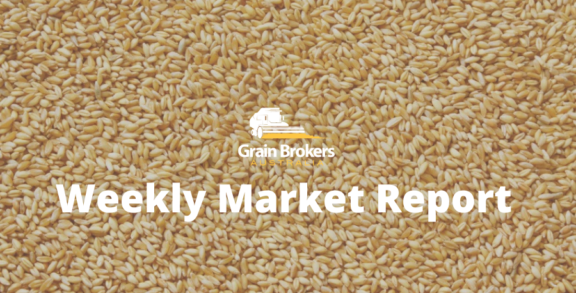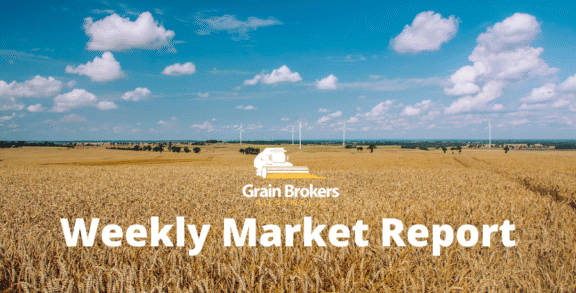
As progress of the winter and spring crop harvest in Russia approaches the three-quarter volume marker, the government is holding firm on its total 2024 harvest and export forecasts, despite official reductions to the final planted area, lower than expected yields in many regions due to a hot and dry spring, and excessive rain causing harvest access and quality issues in other parts of the country’s vast and geographically diverse cropping zone.
According to the Russian Agriculture Minister Oksana Lut, the total grain harvest forecast remains steady at 132 million metric tonne for the 2024/25 marketing year (July to June), with a total grain export target of 60MMT. Visiting the Caucasus Region of Kabardino-Balkaria with President Vladimir Putin, the minister said that the wheat harvest alone is expected to be 86MMT.
However, the minister’s resolve did come with an element of caution, suggesting that the final numbers could be lowered as the harvest campaign draws to a close. Being careful not to be drawn into an official wheat export forecast, the minister added that export quotas and the overall export target would be decided at the conclusion of the 2024 harvest to ensure sufficient grain is retained to cover domestic requirements over the next 12 months.
Russia has been hit by multiple weather extremes this season, ranging from drought and floods to severe early spring frosts. Some grain-producing regions have suffered significant production losses, while as much as 1.1 million hectares have reportedly been totally lost to production this year. And the lousy weather has shown no signs of abating during the summer harvest period, with flooding in the Urals and parts of Siberia adding further woe to a chaotic growing season by hampering fieldwork and leading to quality downgrading in early harvest samples.
At the conclusion of the week ending August 16, the harvested wheat volume was reported at 60.8MMT off 17.4 million hectares, just under 60 per cent of the total wheat area. This compared to the 66.1MMT harvested at the same point in the 2023 harvest campaign. The average wheat yield was reported at 3.49 metric tonne per hectare, around 12 per cent lower than at the same time last year.
Last week, leading Black Sea analyst Sovecon lowered its overall Russian grain harvest forecast from 130.5MMT to 128.4MMT. However, it moved against that trend by adding 400,000MT to the wheat production forecast, increasing it from 82.9MMT to 83.3MMT, reflecting yields reportedly approaching record levels in parts of Siberia and the Urals.
Just a week earlier, SovEcon had clipped 1.8MMT off its wheat crop forecast, claiming the adjustment related to recently published planted area data from Rosstat, the Federal State Statistics Agency, which pointed to a lower total area allocated to winter and spring wheat than the private research firm had initially estimated.
Lower-than-expected yields were also said to have influenced the downward revision. More specifically, the wheat harvest forecasts for the Southern and Central Federal Districts were reduced by 700,000MT to 17.5MMT and 32.5MMT, respectively, due to the persistent dry weather, while the estimate for the Volga Federal District was actually increased by 500,000MT to 18.3MMT.
Whatever the final number, wheat output this year will be significantly lower than the 2023/24 harvest of 92.8MMT, and unless there is a significant turnaround in the spring wheat yields as harvest moves east through the Urals and Siberia, will remain below the five-year average of 86.7MMT.
In the first two months of the 2024/25 marketing year, SovEcon expects Russia to export 8.2MMT of wheat, down from 9.8MMT for the same period last year. Its full-year wheat export forecast currently stands at 48.8MMT, down from 52.4MMT in 2023/24. In the USDA’s global supply and demand update released on August 12, it had this season’s wheat exports pegged at 48MMT from total production of 83MMT.
Meanwhile, Russian wheat exports in the 2023/24 marketing year reached a new high. Shipments from the country’s deep-sea ports increased 6.9 per cent from 39.1MMT in 2022/23 to 41.8MMT last season. Furthermore, considering all export modes and routes, Russian analytical agency Rusagrotrans believes full season wheat exports were more than 55.4MMT, 23.9 per cent higher than the previous season’s mark of 44.7MT.
Grain Gates, a company linked to the state-backed trading house Demetra, was the leading wheat exporter in 2023/24, shipping more than 12MMT. This came after the private trader TD Rif, the leading exporter for almost a decade, fell foul of government authorities who subsequently withheld vital phytosanitary export documentation. A further escalation in the dispute led to a significant reduction in the company’s second-half export quota, resulting in full-year exports of only 7.3MMT. TD Rif hasn’t been sighted in the Russian export market since early May.
While the two biggest destinations for Russian wheat were unchanged, confidence in the quality and reliability of supply saw several Asian importers figure prominently in the export data. Egypt held its position on the top rung of the podium, buying 8.2MT out of Black Sea ports plus a further 0.4MMT on smaller coaster vessels out of the Azov Sea’s shallower ports, compared to a total task of 8.7MMT in 2022/23.
The Republic of Türkiye held the silver medal position with 7MMT, but this was 23.9 per cent lower than the previous season’s purchases of 9.2MMT. Shipments to Türkiye via Russia’s deep-water ports on the Black Sea reportedly more than halved from 6.75MMT in 2022/23 to just 3.3MMT last season.
Iran relinquished third place on the table to Bangladesh, with the latter discharging 3.8MMT of Russian wheat across the season, more than double that of the previous season when shipments totalled almost 1.6MT. Conversely, Iranian imports halved to just 1.3MMT in the wake of lower demand and payment issues.
Indonesian imports went from 168,000MT in 2022/23 to 1.6MMT last year, while the Pakistan program was close to unchanged year-on-year at 1.6MMT. Finally, Russian wheat exports to African destinations, excluding Egypt, increased by 23 per cent in 2023/24 to 8.2MMT, with Morocco the biggest customer purchasing almost 320,000MT.
Call your local Grain Brokers Australia representative on 1300 946 544 to discuss your grain marketing needs.
Written by Peter McMeekin.





